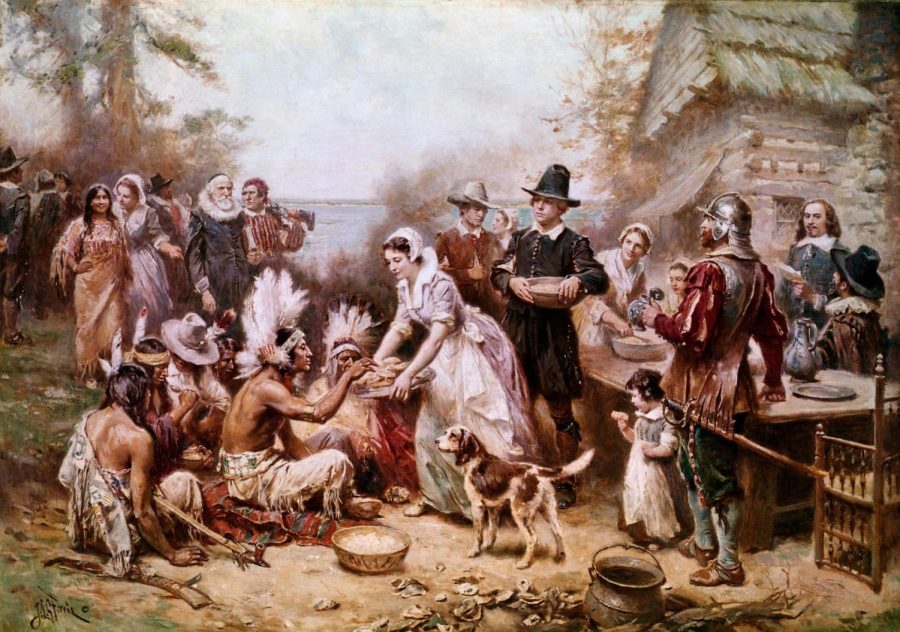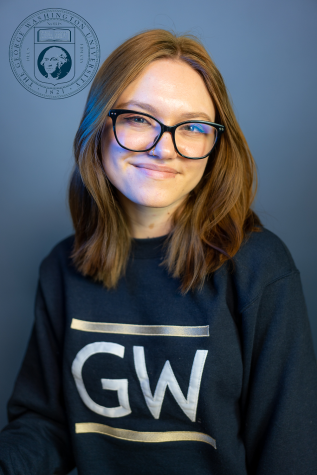The Troubled History of Thanksgiving
You may love the traditional turkey and cranberry sauce of Thanksgiving, but do you know the true backstory of the holiday?
Children are taught that the history of Thanksgiving is a story of friendship with a fairy tale ending. The truth, however, is far more complicated.
November 24, 2021
Thanksgiving bothers me.
My issue with it isn’t the part where people visit their families. It isn’t being grateful for the things we received in the past year. It isn’t even the food, though I think it leaves a little to be desired.
My issue with Thanksgiving starts with how we teach the holiday, because the first Thanksgiving didn’t happen the way were were taught.
It’s true that a group of Puritan Separatists left England in 1620 and then landed in modern Plymouth, Massachusetts. And it is true that the Pilgrims celebrated the end of a good harvest with a feast.
However, there is far more to the story.
The separatists that left England didn’t even leave for fear of religious persecution. While it is true that they were persecuted in England, these separatists had already been in Holland, a place where they were granted religious freedom, for many years. This group of people, like the ones who left for Jamestown, Virginia, left their homes in search of material prosperity.
In the myth, the history of Squanto, or Tisquantum, is roughly glossed over in the story. The Pilgrims did not settle on unclaimed land like many believed. The land was already settled by the Patuxet people, a sector of the Wampanoag tribe. When they arrived, Squanto became a translator between the two groups, taught the Europeans the best way to farm the land, and helped them trade with members of the tribe.
The story does not teach that he was actually captured by the English in 1605 and sent into slavery in Spain. He eventually returned to his home only to find that his entire Patuxet tribe had been killed by smallpox, a common disease brought by European settlers.
Today, we teach children that the idea and initiation of the first Thanksgiving was a kind gesture of the Wampanoag people to the “new” Europeans. The Wampanoag leader, Ousamequin, did not suggest an alliance with the Pilgrims because he was being kind. The Wampanoags had been decimated by a disease and had a very small population. Ousamequin saw the Europeans as a way to protect his already small tribe from an attack by rival tribes. The alliance would later come into use in 1636, when the spread of colonists into Connecticut caused the Pequot War.
Within the story of the first Thanksgiving, there is an implication that this was the first time that the Natives had met Europeans. However, this wasn’t the first time the Wampanoags had been in contact with them. Many parts of Europe were already trading with indigenous people by the time the Pilgrims came.
The Thanksgiving story also fails to address the deterioration of the relationship between the Wampanoag and the Pilgrims due to a growth in European population and the eventual takeover of indigenous lands. The effects of European colonization resulted in a brutal conflict known as King Philip’s War.
Neither English records, which are written, nor Wampanoag history, which is oral, say anything about both groups meeting for a feast. However, many believe that they could have been there considering that both of the groups farmed on opposite sides of the same creek.
In the beginning, a big feast wasn’t even the focal point of the celebration. It was quite the opposite really. Many New Englanders celebrated the day by fasting and praying.
In 1769, Pilgrim descendants started to realize that their cultural authority was starting to be lost as New England became less relevant in the new, growing country.
To combat this, the descendants started to fuel propaganda stating that the original Pilgrims were the birthers of America itself, effectively erasing thousands of years of indigenous history.
What made the holiday what it is today was the blatant lie told by Reverend Alexander Young. He claimed, “This was the first Thanksgiving, the great festival of New England.”
People began to pick up on this footnote, and our modern notion ofd Thanksgiving started to take shape.
It wasn’t until the Revolutionary War and George Washington’s presidency that the idea of giving thanks really became part of the day. In 1789, Washington issued a proclamation for citizens to take part in the day to give thanks for the victory in the Revolutionary War and for the ratification of the Constitution.
While some states had started recognizing the holiday, Abraham Lincoln authorized the national holiday during the Civil War.
In 1862, one year before Lincoln’s authorization, there were mass executions of Dakota tribe members and federal agents blocked members from receiving food provisions. After the Dakota-Sioux decided to fight back in the Dakota War of 1862, Lincoln executed 38 Dakota men.
Thanksgiving became an apology to the Dakota-Sioux and other native who had suffered under the government and the government itself. Regardless, this feeble attempt is just another example of the holiday’s dark history.
Today, Thanksgiving has been romanticized to such an extent that it has become grossly inaccurate. These inaccuracies have led to a perpetuation of colonialism and ignore the atrocities committed that are still affecting natives today.
In fact, this subject is personal for me. I know that my family had a direct impact on American history. I know that my ancestor, William Brewster, helped bring the Pilgrims to the U.S. I know that my ancestors most likely caused the death of many people just by moving. I also know that if we taught the truth of Thanksgiving and shed light on other native historical events, we might not be so eager to celebrate the holiday with a party.
So tomorrow, be thankful for your many blessings. Enjoy a day of relaxation with those closest to you, and have at it when the food hits the table. Just don’t think that the holiday has anything to do a version of history that is not only sanitized for young children but also deeply disrespectful to those who have suffered unjustly.












